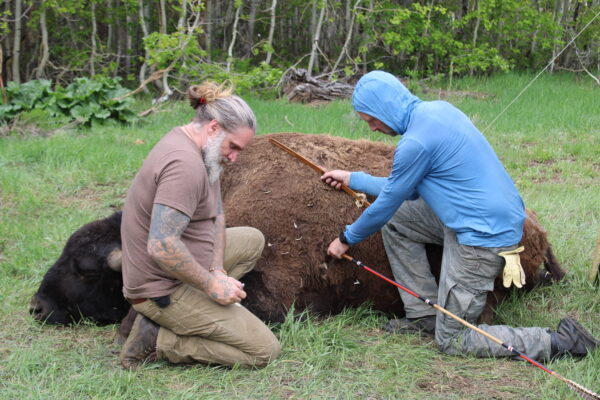A new initiative at the Center for Big Bend Studies and Sul Ross Anthropology Department is the development of an experimental archaeology lab for teaching and research. Few of the tools and technologies we study from the past are represented by accurate modern examples. Experiments and experiences are therefor a necessary part of archaeological work. We rely on our own experiences with comparable tools (for instance cutting tools), as well as historical accounts of similar tool use to interpret past technologies. Experiencing the past through replicas is important both for students and trained archaeologists. However, we sometimes rely on experiences that are not truly analogous to past tools or experiences, which hampers interpretation, and we often lack vital information about how ancient tools performed, broke, or left marks on bone and other materials. Guided experiential teaching with replicas and carefully designed experiments thus have an important place in archaeology. The most effective research in this area compares results of experiments performed by actual humans in field settings that closely mimic past settings (i.e., naturalistic experiments) and experiments conducted in a lab under highly controlled but artificial settings (i.e., controlled experiments). At CBBS we plan to take this two-step approach to an experimental science in archaeology. Our first goal is to fund the construction and outfitting of a lab with indoor and outdoor space applicable for the messy aspects of archaeological experiments; building fires, flintknapping, throwing atlatl darts, and etcetera, and then analyzing the residues of those activities indoors, with sophisticated modern lab equipment. Fortunately, the rural setting of Alpine combined with the academic setting of Sul Ross provides a perfect place for this close marrying of field and laboratory science. If you are interested in donating to our lab please locate the Donate button at the top of the screen and earmark your donation to the experimental lab after adding it to your cart. As our lab develops, we look forward to pursuing the following research and education directives:
Research and Teaching Directives
| Subject | Description |
|---|---|
| Archaeological Ballistics Research | We will continue a program of experiments on humanely culled animal carcasses using spears, atlatl darts, and arrows to better understand how variations in projectiles perform, how stone points break, and the marks they leave on bone. This is type of experiment allows us to capture many variables in a single experiment and use the results to answer broad questions. We will also continue a controlled program of launching projectiles at consistent velocities into artificial targets indoors, which allows us to hone in on more specific questions. Both of these naturalistic and controlled approaches use high-speed cameras, accelerometers, and radar to capture details of weapon impacts and ballistics. The same procedures can even be applied to modern hunting weapons such as testing the efficacy of various steel broadheads. We are currently exploring initiatives with the Wildlife Management department at Sul Ross to unite these interests. |
| Plant Fiber Research | Although stone tools form the most prominent class of artifact in most regions of the world, dry rock shelters in the Big Bend demonstrate that a majority of material culture was formed of more perishable materials such as leather, wood, and plant fiber, which do not preserve on open-air sites. Big Bend cultural materials made from fiber include sandals, baskets, cordage, nets, bags, snares, and much more. Because of the incredible preservation in this region, analysis of plant fiber artifacts, including replication and testing, will be an essential component of our work moving forward. |
| Flintknapping and Stone Tools | Due in part to the durability of stone, flintknapping is the earliest technology to appear in the archaeological record, showing up more than 4 million years ago in Africa. The first flintknappers were early hominins before the appearance of our species, demonstrating that our species has never been without technology thanks to these early innovators. Flintknapping can yield clues to human evolution, and stone cutting and scraping tools, not to mention weapon tips, remained essential everyday items until recently. At Sul Ross we are prepared to devise flintknapping experiments using high-speed cameras for observation, use stone woodworking, plant processing, and butchering tools, and observe macro and microscopic use-wear on experimental tools in a lab setting to better interpret ancient stone tools that do not come with these detailed histories of use. |
| Ground Stone Technology | Experimental research involving ground stone tools can help us better understand effective methods of food processing, for both plant and animal resources, as well as providing comparative material for use-wear studies. Additionally, experimental studies of bedrock mortar production and other grinding surfaces yield data regarding efficiency, purpose, and investment in food processing. Numerous examples of grinding stones (manos and metates) and mortars are found in the Big Bend and surrounding regions. |
| Hide Tanning | Hide and fur tanning were among the earliest and most important innovations that allowed people to move into colder climates. But hide tanning is a tricky process that requires the right tools for the job and strict adherence to a particular method in order to achieve success, yet a variety of different tools and methods have been used. The archaeological record of North America contains numerous classes of stone tools often identified as hide scrapers, and tanning often uses methods of soaking hide in chemicals such as produced by mixing wood ash and water. A better understanding of these tools and methods through experimental approaches would assist interpretation of features and tools used for hide tanning. |


